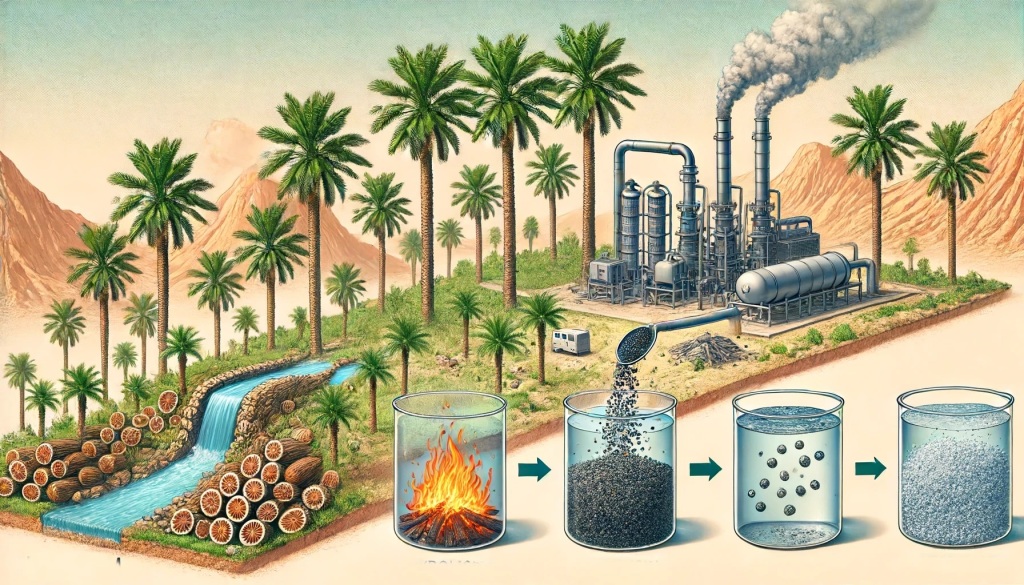Mahmoud, et al (2024) Biochar from Date Palm Waste via Two-Step Pyrolysis: A Modified Approach for Cu (II) Removal from Aqueous Solutions. Processes. https://doi.org/10.3390/pr12061189
Water contamination from heavy metals, such as copper, poses serious environmental and health risks. Industrial processes and agricultural activities often release these metals into water bodies, making it crucial to find effective solutions for their removal. This blog post explores the findings of a recent study that investigates the use of biochar derived from date palm waste for the removal of copper (Cu (II)) from aqueous solutions.
The study focuses on biochar produced from the midribs of date palm leaves through a two-step pyrolysis process. This method involves heating the biomass in the absence of oxygen, first to 300°C and then to 600°C, resulting in a material rich in carbon with a high surface area and enhanced adsorption properties. The biochar was analyzed using various techniques such as scanning electron microscopy (SEM), energy-dispersive X-ray spectroscopy (EDX), Fourier-transform infrared spectroscopy (FTIR), and Brunauer–Emmett–Teller (BET) surface area analysis to characterize its structure and composition.
Adsorption experiments were conducted to assess the biochar’s effectiveness in removing Cu (II) ions from water. Key parameters such as pH, contact time, initial copper concentration, and adsorbent dosage were systematically varied. The results showed that the maximum adsorption capacity was achieved at pH 6, with a capacity of 70 mg/g. This indicates that the biochar is highly effective in adsorbing copper ions from water at this pH level.
The adsorption data were best described by the pseudo-second-order kinetic model, which suggests that chemisorption, involving the sharing or exchange of electrons between the adsorbent and the adsorbate, is the primary mechanism. Thermodynamic studies revealed that the adsorption process was spontaneous and exothermic, with a Gibbs free energy change (ΔG) of −1.245 kJ/mol at 25°C, indicating that the process releases heat and is favorable at lower temperatures.
Moreover, the study demonstrated the biochar’s reusability, showing that it retained over 85% of its initial adsorption capacity after five cycles. This highlights the material’s potential for repeated use in water treatment applications, making it a cost-effective and sustainable solution for heavy metal removal.
Biochar’s effectiveness can be attributed to its unique properties. The two-step pyrolysis process creates a material with a high surface area and a porous structure, which enhances its ability to adsorb heavy metals. The presence of functional groups such as hydroxyl, carbonyl, and phenolic groups on the biochar surface plays a significant role in the adsorption process. These groups interact with the copper ions, forming strong complexes that facilitate the removal of the ions from water.
The study also pointed out that date palm trees are abundant in the Kingdom of Saudi Arabia, with around 23 million trees producing significant amounts of waste annually. Utilizing this waste to produce biochar not only provides an effective solution for managing agricultural waste but also contributes to environmental protection by offering a sustainable method for removing contaminants from water.
In conclusion, the research underscores the potential of biochar derived from date palm waste as an efficient and eco-friendly adsorbent for the removal of copper ions from aqueous solutions. The findings pave the way for future research to optimize the biochar production process and explore its application for removing other contaminants from wastewater. This innovative approach aligns with sustainable waste management practices and offers a promising solution for addressing water contamination issues, particularly in regions facing water scarcity and pollution challenges.






Leave a comment